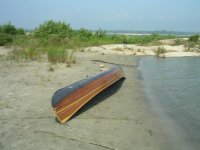The reason I started this topic is that I've been talking to Alex Comb of
Stewart River Boatworks in Minnesota about his Ami and Solitude models. In my remaining canoe time, I'm interested in two things: (1) a light solo that is more initially stable than the four I already own and that may even be "stand-up-able"; and/or (2) a light rib/plank canoe to replace my heavy 17' Old Town wood/FG OTCA that, to put it charitably, disappeared on me.
The 15' Ami, which can be set up tandem or solo, is the only canoe I've found that perhaps could serve both purposes, though it may be too heavy for my increasing ancientness even at 50 pounds in Dacron.
So, I'm also looking at the 14' Solitude, which should be able to come in under 40 pounds. This would be about the same weight as my black-gold Wildfire. But I can't fit my stuffed Duluth pack behind me in the Wildfire, which is where I want it, because of the Wildfire's shallow stern depth and shouldered tumblehome. Hence, I always trip in my deep and roomy 15' Hemlock SRT, but as an early and overbuilt hull, it's becoming too heavy at about 47 pounds. The Solitude seems to have more interior volume than a Wildfire, and this photo of one gives me hope that my packs will fit where I want them:
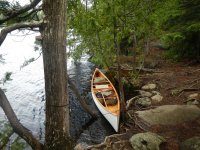
The frustrating thing for a buyer like me is that Alex has no demo fleet except for one model I'm not interested in. I imagine his business is mostly repairs and restorations with new boat sales coming mainly by word of mouth. Not sure, never asked him. But I'm considering driving to Wisconsin and Minnesota just to demo these canoes from some of Alex's customers. Maybe.
Anyway, here's how a wood/Dacron canoe with an epoxy-graphite bottom is constructed by Alex and looks. All these pictures are of the Solitude.
After the hull is ribbed and planked, the Dacron is heat shrunk on with a clothes iron.
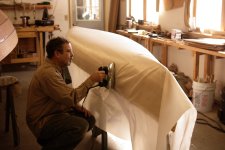
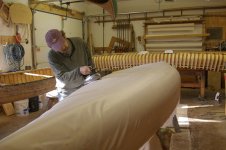
After the Dacron is shrunk-fit on the hull, a weave filler is applied. The ingredients of these fillers seem to be somewhat proprietary, though they are generically referred to as "airplane dope" because the use of Dacron began in the 1950's with builders of lightweight airplanes. In particular, Alex uses something called Stewart Systems EkoFill, and as alternatives he also mentions products called Poly-Fiber and Zinsser 1-2-3.
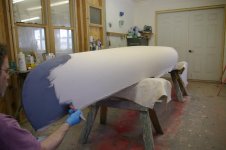
Four or five coats of filler are applied with sanding between coats.
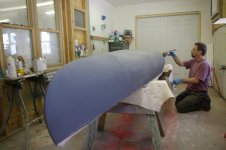
If epoxy-graphite is applied to the bottom, the waterline is taped off and the slurry is rolled and brushed on. Don't know how many coats, but Alex says it adds some weight vs. simply painting the bottom with yacht enamel like the rest of the hull.
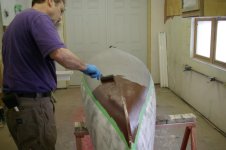
On this boat, he has tinted the epoxy reddish brown. I haven't asked him how many different tint colors are possible. I'd guess light colors wouldn't be feasible given the black graphite powder.
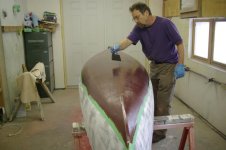
Here, on a different Solitude, is how the epoxy-graphite bottom looks on a newly finished hull. I don't find it particularly aesthetic.
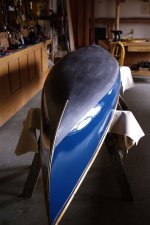
Of course, the epoxy-graphite bottom will be below the waterline when the canoe is in the water. Yet, the aesthetic eye will still see it when the canoe is turned over on shore, stored on racks or being cartopped. (The white canoe is a Solitude.)

Aesthetics are important, especially for a high end wood canoe. The treatment costs $150 according to the Stewart River website, but I haven't asked Alex whether that can vary with boat size. You can see from Waterdog's picture of his Stewart River Prospector above how the epoxy-graphite bottom will look after several years of indelicate use.
So, the question in my mind is: Does the alleged slipperiness, abrasion resistance and hardness of an epoxy-graphite bottom outweigh the decreased aesthetics and increased costs, especially given the unknown (to me) performance of the alternatives?
I take very seriously Waterdog's personal experience and strong recommendations in favor of this treatment. But what I don't know is how the bottom of his hull would have fared in alternative universes, where he would have used the same boat in the same way, but where the bottom had been covered instead by traditional shellac, light fiberglass (which Alex says is also a possibility), new-fangled Wetlander, or simply Epifanes #23 paint like the rest of the hull.
Here are two Amis (Ami's, Amies?) simply painted with no epoxy-graphite bottoms:
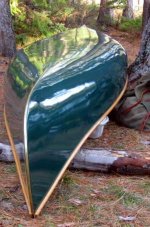
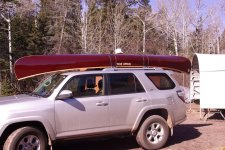
And here's an all fiberglassed Ami made without nails, which eliminates the Dacron bottom issue altogether, but which Alex doesn't want to make again.
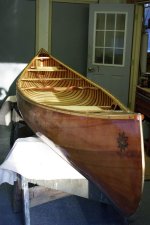
P.S. - All these photos were laboriously plucked and rearranged by me from the more than 500 photos on the
Stewart River Facebook page, which I assume is okay since Alex made them all public for non-FB members like me.







